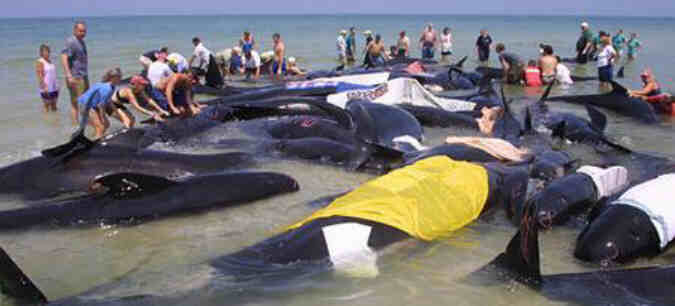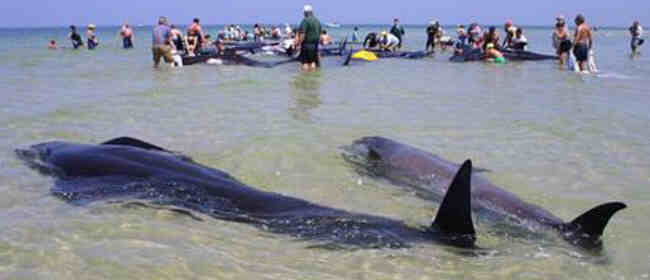beached
pilot whales


| << Jul 28|
HISTORY “4” “2”DAY
|Jul 30 >> Events, deaths, births, of JUL 29 [For Jul 29 Julian go to Gregorian date: 1583~1699: Aug 08 — 1700s: Aug 09 — 1800s: Aug 10 — 1900~2099: Aug 11] |
| On a 29 July: 2001 Elections in Japan for 121 of the 247 seats of the upper house of Parliament, seen as a referendum endorsing Prime Minister Junichiro Koizumi's plans for painful economic changes. The Liberal Democratic Party-led 3-party coalition wins well above the 63 seats it needs to keep control. 2000 In his boat off Acapulco, José Rojas Mayarita, 39, is reeling in a 3-meter marlin when it leaps at him and stabs him through the abdomen. The swordfish's spear comes out the other side. Unable to get up, Rojas would drift for two days in his boat, until another vessel rescues him
1988 FDIC bails out 1st Republic Bank, Dallas, with $4 billion 1988 General secretary of the Communist Party of the Soviet Union Mikhail Sergeyevich Gorbachev, 57, in furtherance of his policies of glasnost and perestroika, pushes plan electing president & parliament of USSR in March, 1989 1988 Judge orders NASA to release unedited tape from Challenger cockpit 1988 South African government bans anti-apartheid film Cry Freedom. 1981 Diana Frances Spencer, 20, becomes Princess Diana of Wales as she marries Prince Charles of Wales in a globally televised ceremony. Years later she would divorce, and die on 31 August 1997 in an automobile accident while fleeing from paparazzi. |
| 1978 Penny Dean swims English Channel in record 7h40m
1978 Pioneer 11 transmits images of Saturn and its rings. 1975 The Nigerian military government of Gen. Yakubu Gowan is overthrown in a bloodless coup led by Brig. Murtala Ramat Muhammad, with Colonel Joleph Garba (17 July 1943 – 01 June 2002) and other middle-ranking army officers, in order to restore democracy within 4 years. In 1978 a National Constituent Assembly approves a new democratic constitution. In 1979 elections Alhaji Shehu Shagari is elected federal president and Dr. Alex Ekwueme vice president. But in 1983 a group of senior military officers under Gen. Muhammadu Buhari seize power. 1974 Watergate: The House Judiciary Committee approves Article II of impeachment by a vote of 28 to 10. The charge is systematic abuse of power and violations of citizens' constitutional rights. Included in this is mention(?) of the 1969-1971 wiretapping program. 1974 The first eleven women priests in the Episcopal Church are ordained in Philadelphia's Church of the Advocate. 1973 Greek plebiscite chooses republic over monarchy
1968 Senior leaders of Czechoslovakia and the Soviet Union met at Cierna to try and resolve their differences over Czech reforms.
1958 Pres Eisenhower signs NASA & Space Act of 1958 1957 International Atomic Energy Agency established by UN 1956 Calypso of Yves-Jacques Cousteau, 46, anchors in 7500 m of water (record) 1952 1st nonstop transpacific flight by a jet
1936 RCA shows the 1st real TV program (dancing, film on locomotives, Bonwit Teller fashion show & monologue from Tobacco Road & comedy)
1921 Adolf Hitler becomes the president of the Nationalist Socialist German Workers' Party (Nazis). 1920 1st transcontinental airmail flight from NY to SF 1915 US Marines land at Port-au-Prince to protect US interests in Haiti., stay until 1924 1914 First US transcontinental telephone conversation (between New York and San Francisco).
1863 Queen Victoria reconfirms British policy of neutrality in US Civil War. 1863 Siege of Fort Wagner, Charleston Harbor, South Carolina continues 1862 At Moore’s Mill in Missouri, the Confederates are routed by Union guerrillas.
1830 Liberals led by the Marquis of Lafayette seize Paris in opposition to the king's restrictions on citizens' rights. 1792 Robespierre demande la déchéance du Roi.
1715 10 Spanish treasure galleons sunk off Florida coast by hurricane
|
| Deaths
which occurred on a 29 July: 2002:: 9 of 55 pilot whales beached on Chapin Beach, Dennis, Cape Cod. Discovered at about 06:00, they were then covered with wet towels and water was poured on them, and at last the survivors, after being tagged, are pushed out to sea when the tide rose enough by noon. They may have been following krill and become stranded in shallow water as the tide went out. An adult pilot whale (Globicephala melaena) is about 5 meters long and weighs some 800 kg. The next morning the same 44 (2 having been found dead in the meantime) surviving pilot whales would again be found stranded in shallow water about 40 km to the east, at a beach in Eastham; 14 of them die on their owen or are killed because blood tests show they are sick, and the remainder is helped to leave at high tide. — MORE ON PILOT WHALES — and more — and more — and more — and more |
| beached
pilot whales  |
| two
dead pilot whales floating 
|
| 1996 Mrs.
Elsie Barker, 84, in Hyde, England, by lethal dose of opiates
administered by Dr. Harold Shipman (murderer
of 215+) during a home visit. 1994 Abortionist John Bayard Britton and volunteer escort James Barrett, shot outside a Pensacola, Florida abortion clinic, by anti-abortion terrorist Paul Hill, 40, a former minister, who would be sentenced to death. He also wounded the doctor's wife, June Britton. 1967: 134 crewmen as explosion and fire ravages US carrier off Vietnam. 62 others are injured. Fire sweeps the US aircraft carrier Forrestal off the coast of North Vietnam in the Gulf of Tonkin. It is the worst US naval disaster in a combat zone since World War II. Of the carrier's 80 planes, 21 are destroyed and 42 damaged. Material damages are estimated at $100 million. 1962 Ronald Aylmer Fisher, English mathematician, born in 1890, whose contributions include the development of methods suitable for small samples, the discovery of the precise distributions of many sample statistics and the invention of analysis of variance. 1960 Richard Simon cofounder of Simon & Shuster
1898 Arturo Michelana, Venezuelan artist born on 16 June 1863. |
| ^
1890 Vincent
van Gogh, from shooting himself in the chest two days
earlier. He was the great Dutch Post-Impressionist painter whose life and death show that there is PAIN in PAINting. He was born on 30 March 1853. Van Gogh’s career as a painter lasted only nine years. His early works were dark but later became intensely luminous after he moved to Paris and the south of France. A great collector of Japanese prints, he created an expressive style that combined direct observation with a Japanese use of outline and flattened areas of color.Van Gogh worked as an art dealer, a teacher and a lay preacher before becoming a painter. Van Gogh was not ‘mad’ but probably suffered from a form of epilepsy easily treatable with today’s drugs. It was only after Vincent van Gogh's death that he gained fame. In his lifetime, he had sold only one painting. In a letter he wrote: “I can’t change the fact that my paintings don't sell. But the time will come when people will recognize that they are worth more than the value of the paints used in the picture.”. It is only posthumously that his prediction was fulfilled... and then some. One of his paintings — the Sunflowers (almost identical to two others) now at the Yasuda museum — sold for just under $40 million at a Christie's auction in 1987. Later another one sold for $82 million (bear in mind that past dollars are worth more than present dollars). — Portraits: Van Gogh by Toulouse-Lautrec — Van Gogh (1886) by John Russell — MORE ON VAN GOGH AT ART “4” JULY — LINKS — Self Portrait — Self-Portrait as an Artist — Self-Portrait with Straw Hat and Pipe — Self-portrait with a Straw Hat — Abris à Montmartre (1886) — Wheatfield with Crows — Premiers Pas — The Potato Eaters — Portrait of Père Tanguy — The Night Café — Starry Night — 15 Sunflowers in a Vase _ Gauguin's Van Gogh Painting Sunflowers — Links to all 11 van Gogh sunflowers paintings — Landscape with the Cloister at Montmajour of Arles — Still Life — Path between Garden Walls (Auvers Landscape) — Women Picking Olives — Beach with Figures and Sea with a Ship — View of Paris from Montmartre — Paris Seen from Vincent's Room in the Rue Lepic — Terrace of the Cafè "La Guinguuette" — The Seine with the Pont de la Grande Jatte — The Vase with Daisies and Anemones — Peach Tree in Bloom. — Self-Portrait with Bandaged Ear — Branches of an Almond Tree in Blossom — Pietà — Good Samaritan — The Church in Auvers — Peasant Woman Seated before an Open Door, Peeling Potatoes The most complete Van Gogh web site A few Self-Portraits of van Gogh [click on an image to enlarge]          Links to all 39-1/2 van Gogh self-portraits |
| 1870 James Baker Pyne, British artist born on 05 December
1800. 1854 Pierre Duval-Lecamus, French artist born on 14 February 1790. 1839 de Prony, mathematician. 1833 William Wilberforce. Ce membre du Parlement anglais en 1780 parvint à faire voter une loi abolissant l'esclavage des Noirs. Jusque-là les négriers pouvaient acheter, à leur guise, des esclaves en Afrique pour les vendre ensuite aux plantations américaines. 1693 The Army of the Grand Alliance, destroyed by the French at the Battle of Neerwinden in the Netherlands. 1649 David Teniers I, Flemish artist born in 1582. 1603 Bartholomew Gilbert, killed in the colony of Virginia by Indians, during a search for the missing Roanoke colonists. 1602 The Duke of Biron, executed in Paris for conspiring with Spain and Savoy against King Henry IV of France. 1164 King Olaf of Norway
|
Births which occurred
on a 29 July:
1907 Melvin Belli Sonora Calif, lawyer, SF's "King of Torts" 1905 Dag Hammarskjöld, Swedish diplomat, 2nd Secretary-General of the UN(1953-61). Nobel Peace Prize (1961). His spiritual journal Markings was published in 1964, three years after his untimely death in a plane crash. 1900 Eyvind Johnson Sweden, novelist (Return to Ithaca-Nobel 1974) 1898 Isidor Isaac Rabi Poland, physicist (explored atom-Nobel-1944) 1883 Benito Amilcare Andrea Mussolini, “il Duce”, dictator (prime minister) of Fascist Italy, 1922-1943. He was killed by partisani on 28 April 1945. 1883 Armando Spadini, Italian painter who died on 31 March 1925. — MORE ON SPADINI AT ART “4” JULY — LINKS 1877 Charles William Beebe, naturalist who explored the ocean depths in a bathysphere 1871 [Gregory Efimovich] Rasputin the mad Russian monk 1869 Booth Tarkington US, novelist (17, Magnificent Ambersons) 1862 Robert Reid, US Impressionist painter who died on 02 December 1929. — MORE ON REID AT ART “4” JULY — LINKS 1849 Edward Theodore Compton, British artist who died in 1921. 1838 Etienne Prospère Berne-Bellecour, French artist who died on 29 November 1910. 1824 Jonathan Eastman Johnson, US painter who died on 05 April 1906. — MORE ON JOHNSON AT ART “4” JULY — LINKS — General Henry Sewall — The Eavesdropper — The Brown Family — The Pension Claim Agent — What the Shell Says — A Day Dream — Woman in White Dress — Old Kate's Bridge, Ulster County — A Different Sugaring Off — The Mother — The Old Stagecoach — The Cranberry Harvest on the Island of Nantucket
1792 Peter Heinrich Lambert von Hess, German artist who died on 04 April 1871. 1629 Peeter van Bredael (or Breda), Flemish artist who died on 09 March 1719. |